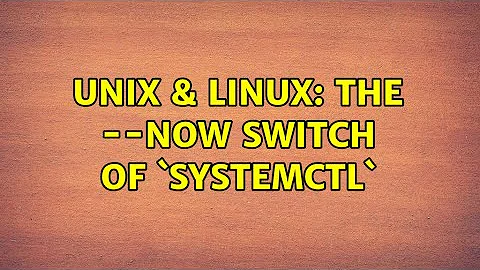the --now switch of `systemctl`
I've found that annoying as well.
Looks like the --now switch was added in version 220 (see this line in the changelog), and CentOS 7 is currently on version 219. Hopefully soon then!
You can check your version of systemd with systemctl --version.
Related videos on Youtube
Martin Schröder
Updated on September 18, 2022Comments
-
Martin Schröder over 1 year
As stated in the man page,
systemctl --now enable servicenameshould enable and start the service.
But it never works for me, under many different distributions.
While the output of:
systemctl is-enabledturns enabled,systemctl is-activeis still inactive for the service.What this switch is good for?
I've tried other combinations such as:
systemctl enable --now servicenameand:
systemctl enable servicename --nowbut still the same; I have to manually
systemctl start servicenameevery time, even if the previous command (ie theenablepart) executes successfully.Is it that the application's implentation of systemd service should support it implementing the feature somewhere in the unit files; what many well-known services do not follow, that made me think its entirely useless switch; I assume thinking over it.
-
 Admin almost 7 yearsAll "combinations" work fine here (archlinux).
Admin almost 7 yearsAll "combinations" work fine here (archlinux).
-
-
 pzkpfw about 5 yearsFYI I am on CentOS 7 and
pzkpfw about 5 yearsFYI I am on CentOS 7 and# systemctl --versiontells me I'm usingsystemd 219but I have verified that the--nowflag indeed starts a stopped service. Maybe RHEL/CentOS backporting? -
 Prashant Lakhera about 5 yearsHi @pzkpfw same for me, even I am on 219 and --now works for me.
Prashant Lakhera about 5 yearsHi @pzkpfw same for me, even I am on 219 and --now works for me.



![[Fixed]System has not been booted with systemd in WSL error | Booting WSL with systemd](https://i.ytimg.com/vi/oILBqhnyCPA/hq720.jpg?sqp=-oaymwEcCNAFEJQDSFXyq4qpAw4IARUAAIhCGAFwAcABBg==&rs=AOn4CLByxpIKADyEYB5QmyNe7DVMod2XSA)

